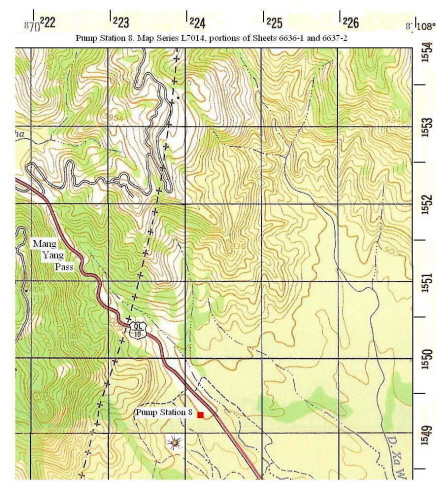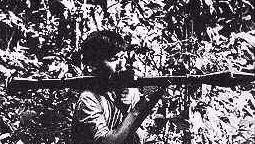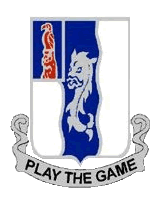"Pump Station Eight"
By Richard A. Rajner
Copyright 2008: Richard A. Rajner. All rights
reserved. (copy permission at bottom)
Webmaster's Comment: The action Richard "Rick" Rajner describes was not his first harrowing experience. During a previous tour before joined the 50th Infantry, his platoon suffered heavy casualties when it was over-run by a large enemy force while on a night ambush in the Iron Triangle. He served with the 1st Battalion (Mechanized) 50th Infantry from February, 1969, as a member of Alpha Company volunteering for and serving with the Short Range Ambush Platoon (SRAP) until it was disbanded on August 31,1969. Rick finished his tour as an Alpha Company 1st Platoon Squad Leader. Rick served one more tour with the Americal Division in 1971 before returning to civilian life. After the war Rick worked as a steamfitter and earned degrees in Antropology and Geography and pursued a doctorate in History, discontinuing his studies when old injuries placed him on the disabled list and eventually forced retirement. He has been a reliable "reference" person for the 50th Infantry Association, having supplied most of the Unit Rosters we have in our Association Archives |
On 21 March 1969
the 1st Battalion (Mechanized) 50th Infantry's Short Range Ambush Platoon (best known by
its acronym, SRAP) fought a brief and bloody battle with elements of the North Vietnamese
Army. The engagement lasted less than thirty minutes, but Pump Station Eight and the
American soldiers defending the installation survived the encounter without suffering
serious damage or casualties, because SRAP held its position in spite of being heavily
outnumbered by the North Vietnamese Army unit sent to destroy the Pump Station. The
fifteen men who ambushed the enemy force blunted the attack, and saw half their number
wounded during the fight. I was one of the fifteen men who helped stop the North
Vietnamese attack and these are my memories of that event.
The operation began in a manner similar to every other ambush patrol conducted by SRAP.
Lt. Leon Walker, the Platoon Leader, was summoned to Battalion Headquarters where the
Intelligence and Operations Staff (S-2 and S-3) assigned the operation. During his
briefing the Lieutenant received updated information concerning the size and disposition
of the enemy force. Lt. Walker, in turn, briefed the platoon. According to a reliable
source an enemy platoon equipped with small arms, rocket propelled grenades and satchel
charges was going to attack Pump Station Eight on the morning of 21 March. The enemy force
was most likely composed of North Vietnamese Army soldiers and would launch their assault
from the forest and brush land south of the Pump Station.
After the initial briefing, which included all members of the platoon, Lt. Walker selected
fourteen men. These soldiers were divided into three five-man teams. Lt. Walker would lead
one team. SGT. Mark Gladson was selected as the leader of the second team. SP/4 Dan
Rayburn was assigned the third team. After dividing his men into fighting units, Lt.
Walker conducted an in-depth briefing. Each team member received his particular task. I
was told that I would carry the radio for Dan Rayburn's team. Then the Lieutenant
carefully described every aspect of the proposed ambush. Each team would occupy a specific
location overlooking either a trail or a ravine leading toward the Pump Station. Radio
call signs, rally points and emergency procedures were carefully reviewed during the
patrol's briefing. At the end of a half-hour, fifteen soldiers were familiar with every
aspect of the operation.

Pump Station 8, Mang Yang Pass vicinity
The proposed ambush gave SRAP an opportunity to enhance its reputation. The plan called
for fifteen, highly-motivated, well-trained and heavily-armed American soldiers to launch
a shock attack upon thirty-odd North Vietnamese whose minds were focused on an objective a
quarter-mile to the north. The ambush site was ideally situated, south of the Pump Station
at a point where the trail and ravine were just a few yards apart. SRAP would be
outnumbered but would have the element of surprise. We would have the opportunity to
detonate our Claymores, throw two grenades into the kill zone and pour automatic fire into
the enemy ranks. If everything went according to the plan, the rapid series of explosions
and gunfire would halve the number of North Vietnamese attacking the Pump Station.
Follow-up volleys of grenades and automatic weapons fire would cut the enemy numbers even
more. The patrol's objective was to trigger an engagement that would last less than five
minutes and inflict heavy casualties on the North Vietnamese attackers, using the elements
of surprise and overwhelming firepower to minimize the risk of SRAP casualties.
In mid-afternoon we drew our ammunition and equipment from the sandbagged CONEX that the
platoon used as a storage locker for its tools of the trade. Each man collected his
readyfor-action gear from the room-sized corrugated metal container. The unit's standard
operating procedure directed that every member maintain a rucksack, ammunition and
explosives meticulously prepared for immediate use. Every rifleman carried six hundred
rounds of M-16 ammunition, two hundred rounds for the team's M-60 Machine Gun, ten hand
grenades, two Claymore anti-personnel mines, a smoke grenade and his personal sidearm.
Machine gunners carried six hundred rounds for their weapon. Their assistant gunner
carried four hundred M -60 rounds, Claymores and grenades in addition to their own rifle
and basic load of M-16 ammunition. I carried the team's radio, two spare batteries, ten
fragmentation grenades, two smoke grenades, an M-79 Grenade Launcher with fifty HE (High
Explosive) rounds, five flare rounds, ten canister rounds, a .45 with three clips in
addition to my personal gear. A gallon of water, two packages of LRRP rations, a poncho
liner, a jungle sweater and spare socks were crammed into my rucksack with most of my M-79
ammunition and the spare radio batteries. In the late afternoon we put on our camouflage
fatigues and loaded up for the ride to LZ Action.
We ate our evening meal at the fire base and passed the time visiting with friends
assigned to fire base duty. After night fell Lt. Walker led us out of LZ Action for our
hike to the ambush site. Constant training made the walk easy despite our heavy loads.
Upon arriving at the ambush site we took our assigned positions. Dan Rayburn and I settled
into a hole overlooking a ravine. Lorenzo Pettis, our Pathfinder-qualified machine gunner
and Andy Soltis, his assistant gunner, guarded our flank and rear. Medic Ventura
Rodriguez, the fifth member of our team, set up next to Andy and Lorenzo. Mark
Gladson’s and Lt. Walker's teams took up positions next to each other, forty yards
west of our assigned location. Within minutes Claymores were in place, grenades were laid
out and Starlight scopes were observing the approaches to the Pump Station. All this was
accomplished silently.
Before midnight we heard noises and saw lights in the forest and brush land to the south.
We whispered reports into our radios describing the enemy activity. Shortly after midnight
a heavy dew settled upon the ambush site. At the same time our radio communications became
unreliable. We could receive some messages, but transmitting a reply was nearly
impossible. Dan Rayburn told me to change the radio battery. Slowly, without making a
sound, I changed the battery. Communications were still poor, a circumstance that I
believed was caused by the dampness. The second spare battery went into the radio after
two missed sit-reps, but neither of the two SRAP radios were transmitting consistently. In
spite of the difficulties we tried to report the lights and sounds that alerted us to the
impending attack.
In the minutes before dawn we heard a metal-on-metal squeal that sounded like an
ungreased wheel. Voices in the distance shouted what could have been commands and then
the noises stopped for a while. These sounds made our hearts beat faster as we waited for
the North Vietnamese to launch their assault. For more than an hour after we heard the
squeak we patiently waited for the North Vietnamese. First light came, sunrise came, but
the enemy did not appear. We heard some automatic weapons fire and some explosions in the
distance, but they were to the north, near the highway and somewhat distant from the Pump
Station. Within a minute an excited voice came over the radio announcing that the mine
sweep was under attack. Just as I was wondering if the enemy canceled the assault on the
pump station, dozens of North Vietnamese soldiers, advancing with weapons at the ready,
emerged from the brush land to the south of SRAP's positions.

We were told that
we were going to ambush a platoon of North Vietnamese ordered to attack Pump Station
Eight, but the enemy force moving up the ravine and trail in front of our ambush site
numbered more than one hundred men carrying AK-47 and SKS rifles, two types of
rocket-propelled grenade launchers and satchel charges. Focused on their objective a
quarter-mile north of SRAP's position, the lead elements of the North Vietnamese seemed
surprised to find American soldiers positioned along their attack routes. The element of
surprise gave the out-numbered SRAP ambush an opportunity to exploit its sole advantage.
Lt. Walker shot an NVA soldier who was a few steps ahead of his comrades. His shot
triggered the ambush. Claymores and hand grenades took a heavy toll, dropping more than
two dozen enemy within a minute of the first shot, but the North Vietnamese opposing us
were good soldiers. They continued the attack in spite of the initial losses. Two minutes
into the fight the NVA were still unable to continue toward the Pump Station, but were
firing at us from close range and trying to maneuver around our ambush. I could hear
Pettis' machine gun pouring bullets into the NVA in short bursts. The stalled North
Vietnamese attackers fired hundreds of rounds toward the SRAP positions, but most of their
bullets passed over our heads toward the Pump Station. Then the battle went all to hell.
Two M-42 Dusters guarding Pump Station Eight began firing 40mm rounds into the trees above
us. The Quad .50 mount at the Pump Station joined in, firing bursts into the middle of the
fight. Rayburn yelled at me to get on the radio. I yelled back, telling him that the
Duster fire was sweeping toward Andy and Lorenzo. Dan left the hole and dragged Andy
backwards toward our position. I grabbed Soltis by the pants and pulled him into the hole.
Then I fired my .45 at the closest of three enemy soldiers approaching from the southeast.
I don't know if I hit the North Vietnamese soldier I was aiming at because a 40mm round
exploded near the three enemy riflemen and knocked them down. I threw grenades at some
North Vietnamese who were nearby and Andy fired his M-16 at another small group armed with
AK-47s.
Meanwhile, Rayburn pushed Pettis into an old shell crater and then dove back into our
hole. Rodriguez had already moved away from his position and was treating a guy with a
chest wound when I looked toward the other teams for a moment. A few minutes later I saw
him tending to other SRAP casualties as shells and bullets came at the platoon from both
directions during the battle. The radio was transmitting and someone answered my calls
directing the Pump Station to "Check Fire," but no one seemed to be able to get
the Dusters or Quad .50 to stop firing. I just kept repeating "Pump Station cease
firing, you're hitting our position." Then things got just a little worse. In the
distance, somewhere to the south, we heard the distinct thump of mortar rounds hitting the
bottom of the tube.
Fortunately, most of the dozen 82mm rounds fired by the North Vietnamese mortar crew hit
outside the SRAP perimeter. While I worked the radio, Rayburn, Soltis and Pettis kept
firing at every NVA that they could see. Lorenzo stopped for a minute when a 40mm round
hit near his position. We thought he was hit but he put out a few long bursts when he
resumed firing again. Then he settled down, demonstrating fire discipline with short
bursts. Andy and Dan took turns popping their heads above the brim of our hole and firing
at the persistent enemy soldiers still trying to advance toward their objective. Finally,
the Dusters stopped firing their guns, followed by silence from the Quad .50. Most of the
enemy fire and movement dropped off at about the same time.
The North Vietnamese soldiers began collecting their casualties while a few of their men
kept skirmishing with SRAP. I fired a canister round at one NVA who was coming toward us
and knocked him backward. Then I went back to my radio work. The traffic on the frequency
was a confused garble of everyone trying to get a message across to someone. An
authoritative voice over-rode everyone and called for "order on the net." Alpha
Company spoke first, letting SRAP know that First Platoon's Armored Personnel Carriers had
reached Pump Station Eight and were on the way to our position. Next in turn, Lt. Walker
spoke over the radio for a few minutes, arranging Med-Evac helicopters for the wounded and
requesting an immediate ammunition resupply for the remainder of his platoon. The enemy
fired a few more bullets in our direction and melted back into the trees. As quickly as it
began, the battle was over.
A platoon from Alpha Company took up positions near our perimeter and some of the APC
crewmen dismounted to help with the wounded. A few soldiers quickly placed charges on
trees and brush, clearing an LZ for the Med-Evac helicopters. After the wounded were
evacuated we were ordered to collect enemy weapons, equipment and bodies. Dan and Andy
went to the spot where the 40mm round exploded near the NVA that I shot at with my pistol.
It was obvious that the 40mm round had dealt the North Vietnamese soldier a fatal blow.
His head, neck and body were shredded, and fragments of steel protruded from his body.
They pulled the dusty corpse out of the dirt and loaded it on the surfboard of the nearest
track. Pettis and I gathered up the NVA I hit with the canister round and two more that he
had machine-gunned. None of these enemy bodies were more than thirty or forty feet from
the hole I had occupied for the last twelve hours. Helicopters landed and lifted off from
the recently-cleared LZ, scattering dust and debris over the ambush site. As the last of
three or four Hueys departed Lieutenant Walker gave the word to load up on the tracks.
Dazed and tired, the remaining members of the ambush patrol obeyed the order.
SRAP transferred to trucks at the Pump Station. We also loaded some of the enemy bodies in
the deuce-and-a-half trucks. When the trucks arrived in An Tuc, the vehicles halted and we
were ordered to unload the NVA casualties into the village square. As soon as we complied,
the villagers began spitting on and kicking the bodies. I turned my head and walked back
to the truck. The ride back to the SRAP hooch was silent. The guys who were not on the
ambush patrol asked questions about what happened. We each told what we saw. Other teams
suffered most of the casualties, but those who returned to the SRAP barracks all reported
that a large number of North Vietnamese soldiers were involved in the attack. Some guys
estimated the number of North Vietnamese was around one hundred. Others said that there
were more than one hundred, perhaps as many as one hundred and fifty. I reported that I
saw at least forty near our position and many more near the other two SRAP positions, but
I had little else to contribute, because I spent most of the battle using my radio.
Unlike most SRAP operations in the past, there was no formal post-operation debriefing or
critique. Lt. Walker talked with us for a few minutes, emphasizing his pride in the manner
in which we stood our ground and hit the North Vietnamese hard. When he left the SRAP
barracks, we resumed cleaning our weapons and equipment. We replenished our rucksacks and
ammo pouches from the small arsenal in our storage CONEX. Then, each man carefully placed
his ruck and web gear along the CONEX wall in preparation for the next operation.
I don’t remember much more about that day. Andy and I went to the PX and bought a
case of beer. A few wounded men drifted back from the hospital or aid station where they
had been treated and added their reports of the battle, supplementing our understanding of
the entire scope of the event. My energy faded at about the same pace as the case of beer.
I took a long shower after drinking two cans of beer. While washing the sweat, grime and
camouflage stick from my body I let my mind drift through the individual segments of the
ambush patrol. When I felt clean I shaved, rinsed off and returned to the SRAP barracks.
The cold brews were gone in an hour or two and I fell asleep. When I woke up the next day
we were preparing to resume our duties as the battalion's ambush platoon. A week later we
were in combat again while conducting an ambush near a strong point along Highway 19.

Copyright 2008 Richard A. Rajner,
Contact via e-mail: rickrajner@yahoo.com
Upon Written Copy permission from the author, you may
link to your web site or reprint this story AS IS with the line below included:
Reprinted from the 1st Battalion (Mechanized) 50th
Infantry Association website http://www.ichiban1.org/
( web sites should make the url a link or may also just link to this page )